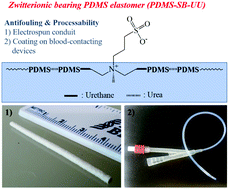A biostable, anti-fouling zwitterionic polyurethane-urea based on PDMS for use in blood-contacting medical devices†
Abstract
Polydimethylsiloxane (PDMS) is commonly used in medical devices because it is non-toxic and stable against oxidative stress. Relatively high blood platelet adhesion and the need for chemical crosslinking through curing, however, limit its utility. In this research, a biostable PDMS-based polyurethane-urea bearing zwitterion sulfobetaine (PDMS-SB-UU) was synthesized for potential use in the fabrication or coating of blood-contacting devices, such as a conduits, artificial lungs, and microfluidic devices. The chemical structure and physical properties of synthesized PDMS-SB-UU were confirmed by 1H-nuclear magnetic resonance (1H-NMR), X-ray diffraction (XRD), and uniaxial stress–strain curve. In vitro stability of PDMS-SB-UU was confirmed against lipase and 30% H2O2 for 8 weeks, and PDMS-SB-UU demonstrated significantly higher resistance to fibrinogen adsorption and platelet deposition compared to control PDMS. Moreover, PDMS-SB-UU showed a lack of hemolysis and cytotoxicity with whole ovine blood and rat vascular smooth muscle cells (rSMCs), respectively. The PDMS-SB-UU was successfully processed into small-diameter (0.80 ± 0.05 mm) conduits by electrospinning and coated onto PDMS- and polypropylene-based blood-contacting biomaterials due to its unique physicochemical characteristics from its soft- and hard- segments.



 Please wait while we load your content...
Please wait while we load your content...